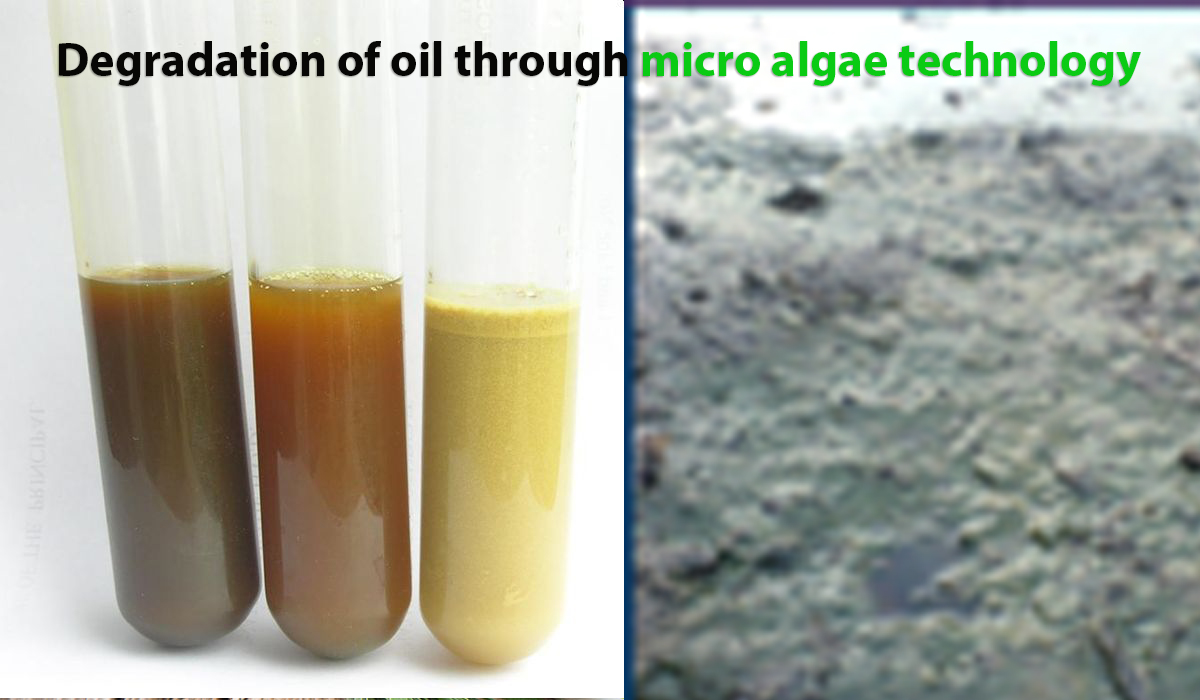
The extensive use of petroleum and petroleum products leads to serious oil contamination of the environment, thus considerable interests were taken in microbial degradation and detoxification of these pollutants. Microalgae play an important role in the environmental cleaning of pollutants. Microalgae provide O2 to aerobic bacteria to mineralize pollutants and then take-up the released CO2. Furthermore, microalgae can help in co-metabolic degradation or produce biosurfactants and extracellular matters to enhance bacterial activity for increasing pollutant bioavailability. Additionally, microalgae can accumulate hydrocarbons, and subsequently make those compounds available to the associated hydrocarbon-utilizing bacteria. The cooperation of phototrophic microalgae and heterotrophic bacteria could potentially improve the degradation of environmental contaminants including oil pollutants.
Petroleum products contain thousands of individual hydrocarbons and related compounds. Their main components are usually subdivided into saturates (n- and branched- chain alkanes and alkylcycloalkanes ) and aromatics (monoaromatic hydrocarbons and polyaromatic hydrocarbons). The less abundant resins and asphaltenes consist of more polar compounds, containing heterocycles, oxygenated hydrocarbons and aggregates with high molecular weight. Given the complexity of oil pollutants, however, it is hard to find a microorganism species that can breakdown a mixture of pollutants completely, one microorganism can only degrade a limited number of crude oil components. Oil-degrading mixed cultures with broad enzymatic capabilities would be required to achieve extensive degradation.
Environmental concern
Owing to ecotoxicological concerns associated with petroleum hydrocarbons, The Environment (Protection) Rules, 1986 of Ministry of Environment and Forests, India has set a permissible limit of 10 mg L−1
Total Petroleum Hydrocarbons (TPH) for disposal or less than 5 mg L−1 TPH for reuse (as oil well injection water) of formation water. Oil field formation water contains TPH in the range of 28 to 126 parts per million (ppm) [ppm = mg L−1, mass per volume] which well beyond thepermissible limits, set by the environmental regulatory agencies. Keeping this in view, the petroleum industry requires to employ efficient and cost-effective technologies to reduce TPH in formation water below the permissible limit.
Bioremediation
Biodegradation encompassing its advantages of complete pol Hydrocarbon degrading bacterial strains are commonly applied for biological treatment of hydrocarbons. However, its application as an effective remediation strategy has been rendered questionable by its requirement of long adaptation periods as well as decreased oxygen saturation levels during hydrocarbon metabolism.
Algae advantage
Algal bioremediation on the virtue of its unique self-sustaining cycle could provide an efficient solution to overcome the above-mentioned drawbacks associated with conventional bioremediation strategies. Algae oxidize organic pollutants into non-harmful metabolites as CO2 and H2O by utilizing oxygen present in the surrounding environment.
Algae perform photosynthesis for its growth, which requires CO2 and H2O. In turn, the oxygen released as a byproduct of photosynthesis could be utilized by algae for further pollutant oxidation, thus repeating the cycle. These properties call for significant attention to elucidate the potential of algae to serve as an effective phycoremediation strategy for removal of hydrocarbons in oil field formation water. Inspite of this, reports exploring the application of algae for treatment of hydrocarbon rich formation water is very severely limited.
PERC’s initiative
Pacific Rubiales at Colombia
Micro algae based remediation technology was successfully implemented at Pacific Rubiales oil drilling site in Colombia. MC pollutants removal capability at the Petrochemical pilot. Aromatic hydrocarbons (HAPs), chlorides, metals, coliforms bacteria, pH and conductivity in the raw and treated petrochemical effluent were monitored. The phycoremediated effluent showed considerable reduction in all that parameters, with a remarkable reduction found in HAPs (99,85 %), and bacterial coliforms (> 97,2%). Reduction of metals levels showed a range between 35 % (Boron) and 93,4 % (Aluminum). Chlorides showed reduction percentages between 69.70% and 79,71%. Finally, conductivity was diminished between 68,22% and 70,23%.
Figure . Side view of the pilot plant to treat the petrochemical effluent of 30 KL of volume capacity.
Figure . Operating diagram of the pilot plant.
Fig showing degradation of aromatic hydrocarbons by algae consortium
Sterlite industry generates huge amount of waste engine oil which needs treatment before discharge. PERC did the initial laboratory scale studies using a variety of robust micro algae isolated from the industry site. One of the species could degrade the oil in a few days of incubation. GC MS analysis showed excellent degradation of emulsion oil and change in colour from brown to dirty orange and becoming hydrophilic.
A Joint Venture Company formed with SAR, a Norway based company providing total solutions in waste chain management for off shore & Onshore Oil & Gas Operators. SAR specializes in environmental services with focus on reduction of waste, recycling and recovery/reuse of valuable base-oil & oil based mud with the prime motto of converting waste to value. SAR, as has worldwide-renowned presence mainly in Europe-Norway, Denmark, Sweden and now expanding in to Asia. Present practices in India allow for easier disposal of water based mud with restrictions on use of Synthetic Oil Based Mud (SOBM). The offshore disposal of wastes is allowed with limitation on discharges.
PERC has set up a scaled up facility to handle the effluent and successfully completed to utilization of entire effluent kept in storage for years in 3 months time.
Degradation of mineral oil
The mud with 20% of mineral oil was disposed in a land fill near the site. PERC has developed an algae technology by employing algae isolated from the oil sludge. The sludge was mixed with regular soil in a ration and allowed algae to establish and degrade mineral oil to less than 2% which is a permissible limit. The sludge turned in to soil on which plants can be grown. Algal treatment improved the texture and water holding capacity of soil.